Last week was a whirlwind for the Federal Reserve, ignited by President Trump’s unexpected decision to dismiss Fed member Lisa Cook. Rumors of policy shifts had swirled following Fed Chairman Jerome Powell’s comments, hinting at potential interest rate cuts. Yet, Trump’s clash with Cook overstepped into unanticipated legal territory, marking September as a month filled with potential surprises.
What Led to Cook’s Legal Action?
Cook immediately responded to her dismissal with legal proceedings, arguing the president lacks the authority to remove her. Court documents reveal Cook’s plea to maintain her position, suggesting Trump’s actions were an overreach of his powers. This moves the conflict into the judicial arena, with Powell also named a defendant.
Did Trump Have Just Cause for Removal?
Indeed, Trump cited allegations of mortgage fraud as cause for Cook’s termination, accusing her of misrepresenting her primary residence in 2021. Historically, Presidents have removed heads of independent agencies without just cause, but the Federal Reserve requires a valid reason for such actions.
The timing of Cook’s alleged misconduct coincides with a period before her Fed appointment, posing legal complications for the upcoming trial. A White House official suggests Trump believes his actions align with legal norms, though the contentious nature of the trial is unavoidable. A successful defense might affirm Trump’s stance but challenge Fed autonomy.
Fed’s Independence: A Historical Perspective?
The Federal Reserve’s independence has only been a principle for the past 70 years. Before the 1951 Treasury-Fed accord, the Fed was integrally linked to fiscal policy, with its role in financing World War II showcasing this connection.
“Trump plans to swiftly reduce interest rates by appointing four of his allies to the 12-member committee and subduing the rest through intimidation,” commented a Turkish analyst.
The perception of independence is recent, and Trump’s grip on the Fed could reverse decades of policy autonomy, echoing pre-1951 conditions. Historically, these periods of intervention linked monetary and fiscal policy closely, affected by factors like wartime economies and bond financing.
- Cook’s lawsuit challenges the boundaries of presidential power over independent agencies.
- The Fed’s autonomy is again under scrutiny as Trump confirms an interest rate reduction agenda.
- For three years, expect economic turbulence influenced by presidential politics and market perceptions.
e507 foresees an uncertain yet dynamic phase ahead for financial markets, including cryptocurrencies, stocks, and gold, as Trump pursues significant economic shifts. The long-term impact remains an open question.
“For at least the next three years, the global economy faces a turbulent yet fascinating journey.”
Trump aims to position the economy favorably for future elections, with interest rate cuts intended to highlight economic growth. As this strategic narrative unfolds, its effects on market sentiment and regulatory practices will be closely watched.
Disclaimer: The information contained in this article does not constitute investment advice. Investors should be aware that cryptocurrencies carry high volatility and therefore risk, and should conduct their own research.
















 English (US)
English (US)